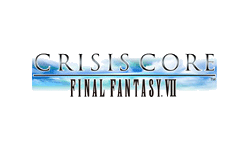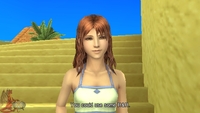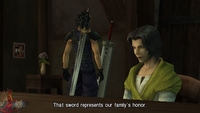|
|

|
PLATFORM
|
PSP
|
BATTLE SYSTEM
|

|
INTERACTION
|

|
ORIGINALITY
|

|
STORY
|

|
MUSIC & SOUND
|

|
VISUALS
|

|
CHALLENGE
|
Adjustable
|
COMPLETION TIME
|
20-40 Hours
|
|
OVERALL

|
+ Excellent story with great characters.
+ Great soundtrack with old and new music.
+ Terrific voice acting.
- Real-time battle menu is awkward.
- DMW leaves too much to chance.
- Optional missions are all the same.
|
Click here for scoring definitions
|
|
|
Ahh, Final Fantasy VII. Quite possibly the most popular game in existence. Its fanbase contains more raving lunatics than any other game, and any attempts to disparage what many consider the epitome of RPG gaming can be assuredly met with vicious insults and possibly egregious bodily harm. It's no surprise, then, that Square-Enix decided several years ago to extend the popular game into a Compilation of Final Fantasy VII, a series that transcends multiple forms of media. After the story of the world of Gaia and its lifestream was extended in Dirge of Cerberus and Advent Children, Square-Enix has finally brought the latest episode in the series, Crisis Core: Final Fantasy VII, to North America.
Crisis Core takes place several years before the events of Final Fantasy VII, and focuses on a character whose existence in the main game consisted of little more than fragmented memories, and yet was vitally important to some of its most memorable and significant scenes. Zack Fair, a 2nd class member of the Shinra Electric Company's elite military unit, SOLDIER, has aspirations of greatness, and great respect for his 1st class comrades, Sephiroth, Genesis, and in particular his mentor, Angeal. However, Shinra is at war with Wutai, and Genesis has gone missing while on assignment there. Zack and Angeal are assigned to clean up the mess. While much of the game focuses on the untold story of Zack and his rise to SOLDIER, 1st Class, the most interesting and imporant aspects of the story are spent detailing the events that eventually lead to Final Fantasy VII, including Sephiroth's descent into madness, the origins of the Buster Sword, and Zack's relationship with Aerith (or Aeris, if you prefer.)
To say the least, Zack's story is excellent. Final Fantasy VII's weak translation led to a lot of confusion over its events, but Crisis Core clears them up extremely well. In particular, one of Final Fantasy VII's most memorable events, the destruction of Nibelheim, is retold flawlessly and with much more detail. Zack is a likable and intriguing protagonist, possibly more so than Cloud himself, and the relationships he develops with the rest of the game's cast form one of the more impressive aspects of the story, right up to the inevitable and tragic conclusion.
The story is told through a series of linear missions across a number of familiar and new locations. As a member of SOLDIER, Zack's job is to resolve Shinra's issues through pure physical force, and he does it well. Combat in Crisis Core is done in real time, using the L and R buttons to cycle through commands and using the X button to select them. The simplest ability is Zack's sword attack, which can be comboed easily and delays enemy attacks, but Zack can also make use of materia abilities and items. This menu system bears a striking similarity to that used in Kingdom Hearts, and although slightly more streamlined, still suffers from its cumbersomeness, particularly when trying to use items. Zack can also dodge and guard against enemy assaults, and most battles consist of using a combination of attacks and dodges. While it does a fantastic job of keeping the player actively engaged in the combat, it does become rather repetitive after a while, and a lack of diversity in enemy attack patterns doesn't help things much. The encounter rate can also be needlessly high at times, adding to the repetition.
 Too sexy for the Turks
Too sexy for the Turks
|
|
Experience has been done away with in Crisis Core. Instead, character progression is handled through the DMW — the Direct Mind Wave — reel. The DMW is basically a slot machine with character pictures and numbers that constantly spin and stop during battles. When the left and right character pictures activate, Zack enters Limit Verge mode, during which the numbers and middle character panels continue to spin. If all three character reels line up, a Limit Break is activated, while matching numbers can trigger various effects. Any combination of two identical numbers will cause the materia equipped in that slot to level up once, while matching all three will increase it by two levels. If the reel stops on triple 7's, Zack levels up.
Thankfully, levelling up is not purely random but based on a weighted probability system. Once Zack has killed enough enemies to level up, the odds of hitting a triple 7 constantly increases until it finally does. While this effectively solves the most pressing concern, the randomness of the system still has its issues. For one thing, while levelling is scaled, levelling materia does not appear to be. It is virtually impossible to predict when any given materia is going to increase, and it isn't uncommon to go for significant lengths of time without increasing a level. Thankfully, a materia fusion system exists in the game. Using this system, it is possible to combine two materia into a new one, sometimes providing a new spell or possibly improving the materia's stat bonuses, effectively negating the need for materia levelling.
Which Limit Break Zack performs is also entirely random, which strips a lot of fun away from these generally spectacular attack sequences. Furthermore, the odds of entering Limit Verge seems to be heavily based on the level of enemies Zack is fighting, which can make utilizing any of the DMW's features quite frustrating.
The DMW isn't all bad, though. Even when Limit Verge doesn't activate, if one or more 7's appear, various status buffs are activated, including removing MP costs, nullifying magic or physical damage, and even making Zack completely invincible for a short time. Limit Verges also have a secondary function of adding to the story in a surprisingly unique and enjoyable way. During Limit Verges, as the character wheel is spinning, short movie sequences or still images involving Zack's relationship with those characters may show up. These movies are usually extensions of previous scenes from the game, and their appearance virtually guarantees a Limit Break activating. The Limit Verge is used to particular effect in the game's ending, a sequence that is poetic, beautiful, and sure to bring a tear to the eye.
 The origins of one of gaming's most famous swords.
The origins of one of gaming's most famous swords.
|
|
One of the odder features of Crisis Core is the fact that approximately 50% of the gameplay is optional. These occur in a group of 300 missions that Zack can set out on from any save point. Unfortunately, these missions are all pretty much identical: find the boss and kill it. They are all, of course, entirely optional, but sadly, nearly all of the game's most important items — summons, increased accessory slots, and materia fusion upgrades, for instance — are found in these missions, making skipping them a poor decision.
Visually, Crisis Core is quite possibly the most impressive game to grace Sony's handheld. When compared to the state-of-the-art graphics Final Fantasy VII brought us ten years ago, it's a remarkable contrast to see just how far we've come, and on a portable console nonetheless. In particular, the characters' faces are remkarkably expressive, unsurprisingly bearing a striking resemblance to those seen in the Kingdom Hearts games, as the character designer for both is the same Tetsuya Nomura. Unfortunately, many of the environments, particularly those repeatedly seen during free missions, are quite bland, though there are several exceptions. The city of Midgar is faithfully recreated from its PlayStation origins, as is the village of Nibelheim and a few other key areas.
Crisis Core also offers up a masterful audio experience. The soundtrack is composed of new tracks as well as remixes of classic Final Fantasy VII tracks, including the main theme, Aerith's theme, One Winged Angel, and the main battle theme. The voice acting is also excellent, with the cast of Advent Children all reprising their respective roles.
Overall, Crisis Core is an uneven experience. For all the good it offers, there's an equal share of frustration. The story alone is enough to recommend it to avid RPG fans, and it is unquestionably a required play for all the aforementioned raving lunatics. While the DMW is irritatingly random, the battle system is nevertheless a fairly enjoyable experience. The game is depressingly short, however, with the main story only taking about 15 hours or so to complete. The optional missions can add a massive chunk of time to that total, but as previously mentioned, are quite repetitive. It's also pretty much devoid of challenge. The majority of the game takes virtually no effort to complete, and is made even easier if the player chooses to partake in optional missions. A hard mode is available, however, but the difference between the two is rather striking. The default is too easy while the hard mode will likely prove frustrating for most players. Avoiding the free missions entirely can provide a decent challenge, but it has its consequences as mentioned earlier. Crisis Core: Final Fantasy VII is an impressive prequel to one of the most popular games of all time, but far from perfect.
Review Archives
|









